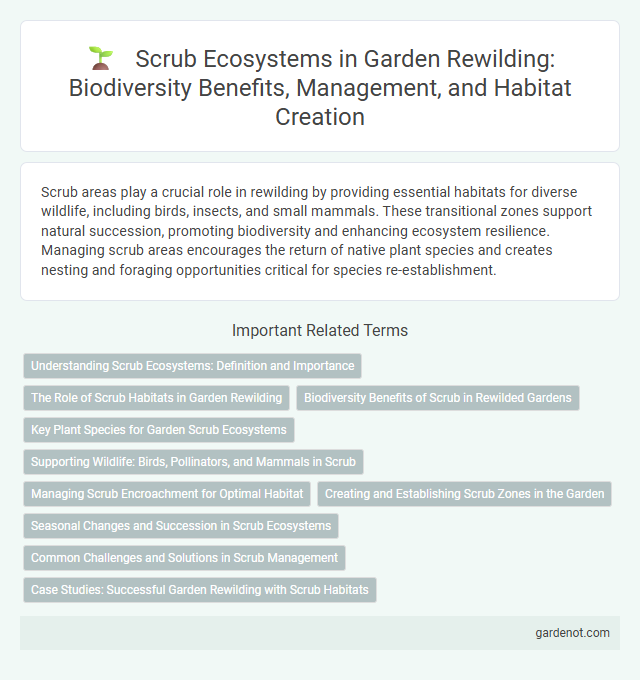Scrub areas play a crucial role in rewilding by providing essential habitats for diverse wildlife, including birds, insects, and small mammals. These transitional zones support natural succession, promoting biodiversity and enhancing ecosystem resilience. Managing scrub areas encourages the return of native plant species and creates nesting and foraging opportunities critical for species re-establishment.
Understanding Scrub Ecosystems: Definition and Importance
Scrub ecosystems consist of dense vegetation dominated by shrubs and small trees, providing critical habitats for diverse wildlife species. These areas support biodiversity by offering food, shelter, and breeding grounds, while also playing a key role in soil stabilization and carbon sequestration. Understanding scrub ecosystems is essential for successful rewilding efforts, as their preservation enhances ecological resilience and landscape connectivity.
The Role of Scrub Habitats in Garden Rewilding
Scrub habitats in garden rewilding provide crucial shelter and food sources for a diverse range of wildlife, including birds, insects, and small mammals. These areas promote biodiversity by supporting native plant species that thrive in dense, woody growth, creating microhabitats essential for pollinators and ground-nesting birds. Incorporating scrub zones enhances ecological balance, boosts natural pest control, and fosters resilient ecosystems within urban and suburban garden environments.
Biodiversity Benefits of Scrub in Rewilded Gardens
Scrub areas in rewilded gardens create crucial habitats supporting diverse species, from insects to small mammals, enhancing overall biodiversity. Dense vegetation provides shelter, nesting sites, and food resources, promoting ecological balance and resilience. This natural complexity aids pollination, pest control, and soil health, contributing to a thriving, self-sustaining ecosystem.
Key Plant Species for Garden Scrub Ecosystems
Key plant species for garden scrub ecosystems include native shrubs such as broom (Cytisus scoparius), gorse (Ulex europaeus), and heather (Calluna vulgaris), which provide essential habitat and food sources for wildlife. These hardy, drought-resistant plants promote biodiversity by supporting pollinators like bees and butterflies, and they help stabilize soil, reducing erosion in rewilded scrub areas. Incorporating diverse scrub species enhances ecological succession, fostering a resilient and self-sustaining garden ecosystem.
Supporting Wildlife: Birds, Pollinators, and Mammals in Scrub
Scrub areas provide essential habitat diversity, offering shelter and foraging resources that support a wide range of birds, pollinators, and mammals. Native shrubs and dense vegetation create nesting sites and food sources, boosting local biodiversity and enhancing ecosystem resilience. Maintaining and restoring scrub habitats promotes healthy populations of species such as songbirds, bees, butterflies, and small mammals critical to natural rewilding processes.
Managing Scrub Encroachment for Optimal Habitat
Managing scrub encroachment in rewilding projects involves controlling invasive shrub species to maintain open habitats essential for biodiversity. Techniques such as selective cutting, controlled grazing, and periodic burning help prevent scrub overgrowth that can reduce habitat quality for ground-nesting birds and pollinators. Effective scrub management promotes a mosaic of vegetation structures, enhancing habitat complexity and supporting diverse wildlife populations.
Creating and Establishing Scrub Zones in the Garden
Creating and establishing scrub zones in the garden enhances biodiversity by providing essential habitats for pollinators, small mammals, and birds. Strategic planting of native shrubs such as hawthorn, blackthorn, and gorse supports natural food chains and encourages ecological balance. Integrating diverse scrub areas promotes soil health, aids in carbon sequestration, and increases resilience against climate change impacts.
Seasonal Changes and Succession in Scrub Ecosystems
Scrub areas undergo dynamic seasonal changes that influence species composition and habitat structure, driving natural succession processes critical for ecosystem diversity. Early successional stages in scrub ecosystems often feature pioneer plants that prepare the soil for more complex vegetation, while later stages see the establishment of shrubs and young trees that stabilize the environment. Monitoring these seasonal shifts enhances understanding of ecological succession patterns, informing rewilding efforts aimed at restoring native habitats and promoting biodiversity.
Common Challenges and Solutions in Scrub Management
Scrub management often faces challenges such as invasive species invasion, limited biodiversity, and fire risks due to dense undergrowth. Effective solutions include targeted grazing, controlled burns, and selective cutting to maintain habitat diversity and prevent overgrowth. Monitoring and adaptive management ensure scrub areas support native wildlife while mitigating ecological threats.
Case Studies: Successful Garden Rewilding with Scrub Habitats
Case studies of successful garden rewilding demonstrate how scrub habitats significantly enhance biodiversity by providing shelter and food sources for pollinators and small mammals. Transforming underutilized grass patches into dense scrub areas attracts native bird species such as wrens and blackbirds, promoting ecological balance. These projects highlight effective methods of natural succession management, emphasizing low intervention to foster resilient ecosystems within urban and suburban gardens.
Scrub Area Infographic

 gardenot.com
gardenot.com